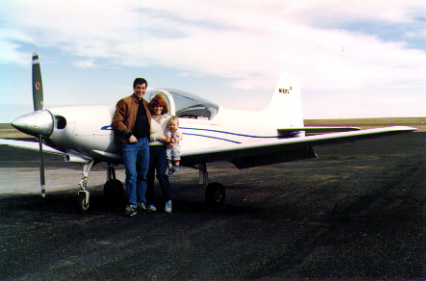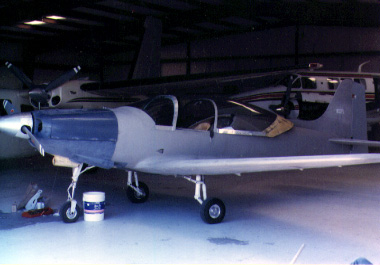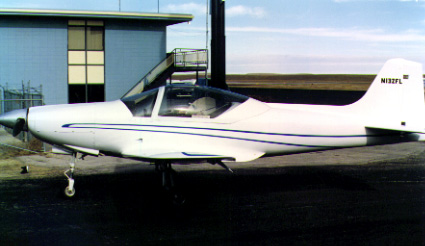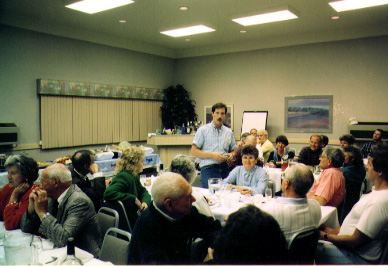First Flight, Jimmy Shaw
![]()
First Flight, Jimmy Shaw |
|
by Alfred Scott
This article appeared in the June 1985 issue of the Falco Builders Letter. |

Jimmy and Sharon Shaw with their two babies.
Some of you may remember the plight of Jimmy Shaw, who had to fly his Falco by April-or he was in trouble. Jimmy is in the Air Force and began his Falco knowing that he was going to be transferred in April '85. He made it, and on April 17, he became the third Falco builder to fly. Jimmy has a 160 hp O-320-B3B engine from a Piper Apache, and he also got the governor with the engine. He installed our cowling and baffling in the course of a couple of days. Because of the rush to fly, Jimmy's Falco was not really complete at the time he flew it. The gear doors were not installed, the bottom of the wing was open between Sta. 2 and 2-1/2, and the nose gear bay cover was not installed, thus providing him with a view of the ground that few Falco pilots have ever seen! (Interestingly, the lower air pressure pulled air out of the cockpit.) The Falco was still in a khakie-colored primer when he flew and was not going to be painted until later.
Jimmy had quite a problem on his first two flights. Those of you that really know what you are doing will already know what the problem is from the preceding paragraph. Before you read on, go back and see if you can spot the problem.
On his first flight, Jimmy had an 18 kt quartering crosswind. He did a couple of high speed taxi tests and then took off. It flew nearly hands off, rolling a little to the left. He found the rudder highly effective and the controls much lighter than he had expected (Jimmy is an instructor flying Cessna T-37's). He cranked the gear up-the gear circuitry was not yet complete-and indicated only 100 kts. The engine speed was high-2900-3000 rpm-so he reduced power to 2600. After switching to the aft tank, Jimmy had a sudden power loss, and the fuel pressure went from 6-7 psi to 3-4. He switched back to the front tank and landed. There was a big celebration, champagne, and then Jimmy started to make up a list of things to correct. He had to change the rpm setting on the governor, check the fuel system, and check the pitot-static system, among other things.

I am telling you this tale in the order that it came about in our conversations, so you will find the true nature of the problem as unclear to you as it was to Jimmy and me at the time. Jimmy checked out the fuel system and pitot-static system and found no problems. He tried to make some adjustment to the speed of the governor but was having some difficulty with that. On the second flight, he had the same sudden drop in engine speed, down to about 900 rpm, and quickly landed to think about it. Jimmy said that he had never flown with a constant speed propeller before and was thinking about getting some dual before flying his Falco again. He also mentioned that the governor control was very sensitive, it seemed to him. He said it was a good thing that he wasn't used to flying with one of the things since it didn't bother him that high rpm was full back on the quadrant. Also, he had not been able to adjust the high rpm setting on the governor since the adjustment screw was in the wrong place on the governor, and the spring forced the arm of the governor to the low rpm position. The engine was running very fast on takeoff, about 3000 rpm and getting faster after airborne. He came back on the throttle to keep the engine speed under control. The airspeed was still only 100 kts.
I spent the evening thinking about this, and it slowly dawned on me what was going wrong-Jimmy was using the wrong type of governor for this propeller. I called Jimmy early the next morning and explained this to him. It took a while for him to understand, but it gradually started to make sense. The following day, he got his governor shop to exchange governors and the airplane flew well.
Jimmy remembered that he had switched tanks and then was making an adjustment to the prop control when the "power loss" occurred. The drop in the fuel pressure was meaningless, since carbureted engines will run on as little as .5 psi. When the engine went from 2900 to 900 rpm, the engine-driven fuel pump was not pumping as hard, so the decrease in fuel pressure was normal, as was the airspeed. The propeller was in the flattest possible pitch, and Jimmy had been reducing power to keep the engine speed down.
Gentlemen, it is now time for "The Lesson On Governors". Governors come in two types: oil pressure to increase pitch and oil pressure to decrease pitch. The natural tendency of a propeller is to decrease pitch, since propellers are lazy and want to do as little work as possible, so for single engine aircraft the governor sends oil pressure to the prop to force it into a higher pitch (lower rpm) position. With twin engine aircraft, it is desirable to have the prop go into a feathered position when an engine quits, so counterweights and springs are installed to make the prop go into a feathered position. Thus, the governor has the job of forcing the propeller into the low pitch (high rpm) position.

So what Jimmy Shaw had was the mechanical equivalent of a Groucho Marx skit, with the governor saying "go slower" and the propeller understanding this as "faster". Because of the way the springs and weights are designed in the governor, the action is not smooth-more like the action of the boom when the sail jibes on a sailboat. Suffice it to say that this is not the way governors are supposed to work. You must have a governor designed for the propeller that you have. You should also be aware that all single engine governors are not alike. The Continental engines have a different governor speed in relation to the engine than the Lycomings that we use. The governor that we are using is the Woodward B210345 which is used on the Mooney. You could also use the McCauley governor used on the 177RG and other single engine Cessnas with a constant speed prop and Lycoming engine. Since we can get the governors at an OEM price, we have added the governor to our price list.
Once Jimmy got the right governor on the Falco, all went well and he flew it for 1.7 hours. The stalls were at 62 kts with flaps and 65 kts clean. He ran a number of tests on the Falco and was generally pleased with it. Because the Falco was extremely dirty, the speeds were low-only 140 kts indicated at 25"/2500. He took the Falco up to 170 kts in a shallow dive.
Jimmy Shaw built his Falco, N132SL, in 2 years, 10 months and 2 weeks. It was his first homebuilt aircraft, and he bought the rib kit and fuselage frame bare bones from Trimcraft, but made all other wood parts. He used most of our kits for the aircraft, but made a few things himself. The Falco is surprisingly light: 1,120 lbs empty in primer, so with final painting he should weigh in at 1,140, and that is with two Terra Nav/Coms. The center of gravity came out fine and required no adjustments. This summer, Jimmy is stationed at Castle AFB in California for training for his new post, which will be Rapid City, South Dakota. Jimmy planned to move the Falco to California for painting, but I haven't heard from him since his move. He did not expect to make Oshkosh, although there is always the possibility that he might come now that Mr. Frati is coming.

Jimmy Shaw at the West Coast Falco Fly-In.